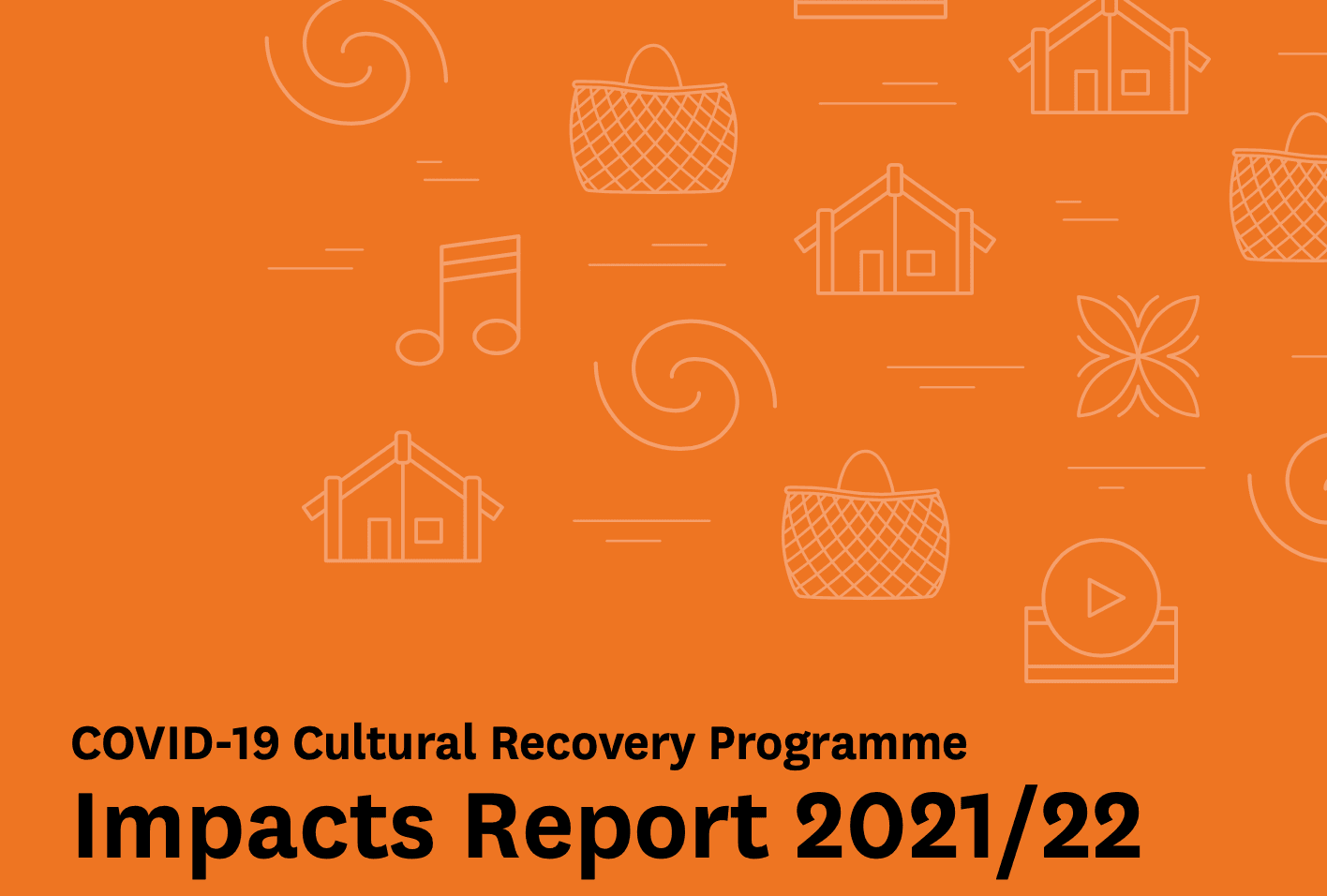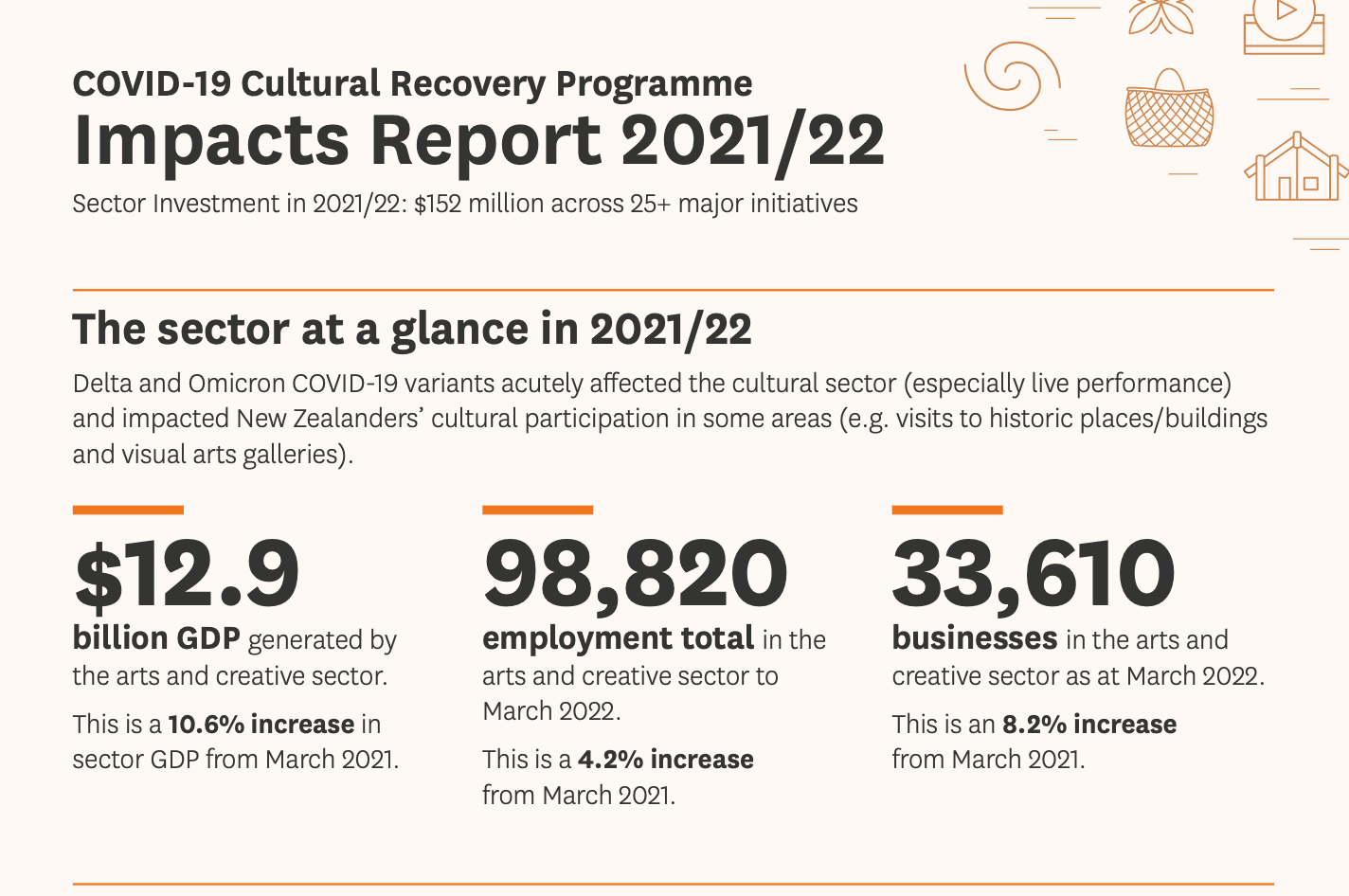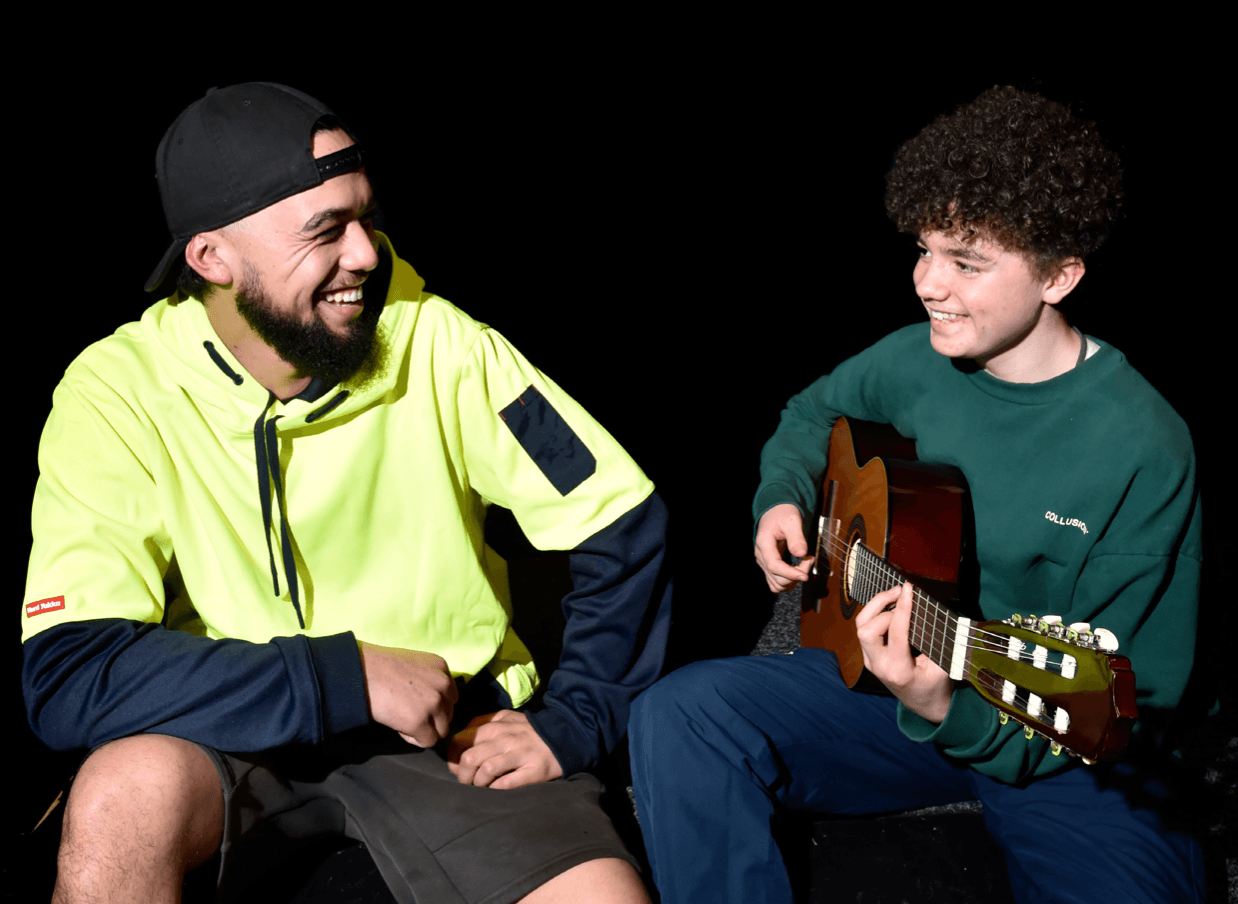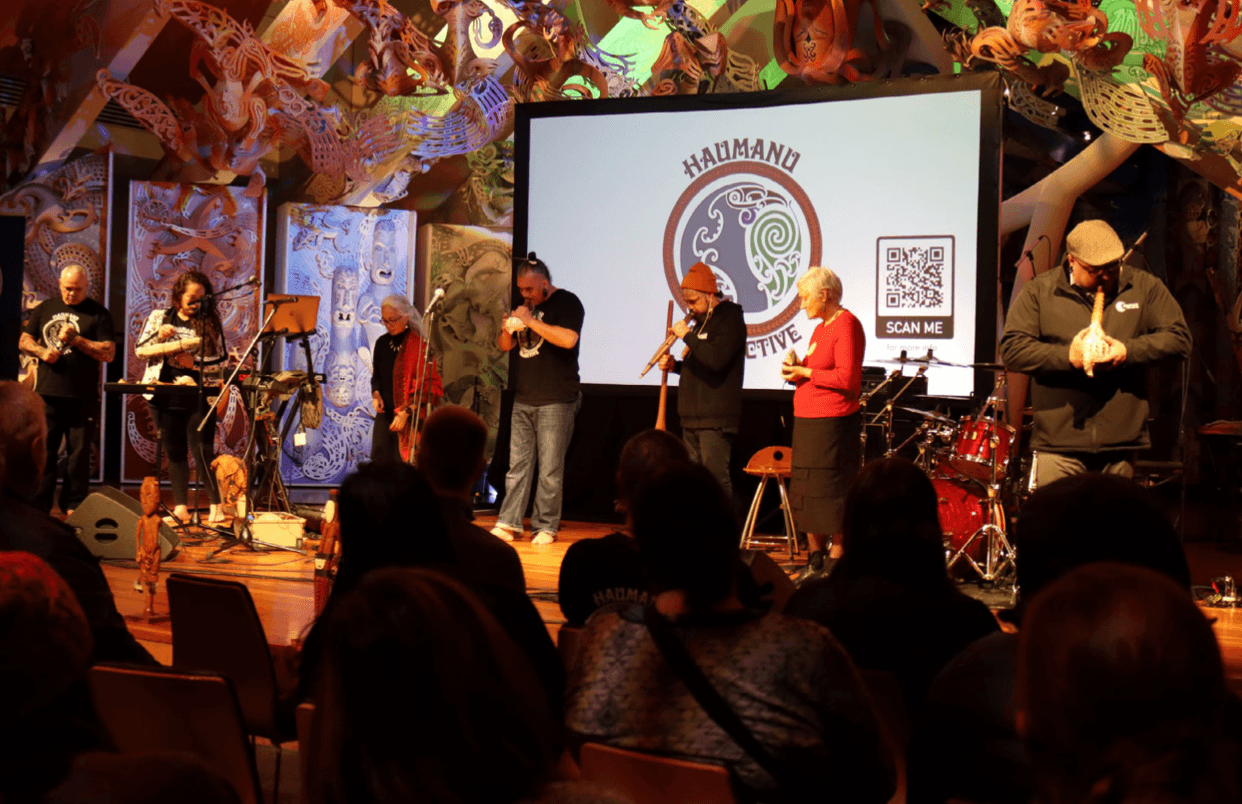More Jobs, More Money, More Mahi - New Report Highlights Big Gains For Cultural Sector
MCH has just revealed its latest report into the key stats and impacts for the cultural sector - with GDP growth at twice the rate of the total economy. Read all the key details.
Written by

New statistics released by Manatū Taonga Ministry for Culture and Heritage (MCH) have found that the creative industries have taken new leaps forward - highlighting their importance to Aotearoa.
The latest COVID-19 Cultural Recovery Programme (CRP) Impacts Report has been made public this morning - measuring the period of March 2021 through to March 2022 - using the previous year's report as a measuring stick.
The reports are based on evaluating the economic impact of the Government’s historic, almost half a billion dollars investment in the arts and culture sector through the course of the pandemic.
The data collected in the 72-page report tells an important trend - employment, business and GDP have all grown in 2022.

Minister for Arts, Culture and Heritage Carmel Sepuloni additionally points out that the employment growth numbers are even more impressive, given there had been a forecasted loss of nearly 11,000 jobs in the sector.
“Supported by our Government’s investment, these employment and business results contributed $12.9 billion to our economy’s GDP, a growth of 10.6% compared to 5.3% for the total economy.
“We know the economy has grown strongly and is showing its resilience with the arts and culture sector playing its role to support our wider economic recovery.
“Our Government’s investment has and will continue to see more jobs created. High-level modelling suggests that we will see nearly 1,000 more jobs for the sector and over 1,600 more jobs in the wider economy – these are the flow-on effects on employment when the arts and creative sectors are supported to flourish and thrive.
“When COVID-19 hit, we acted quickly to put in place programmes that could protect and preserve the financial viability of arts and cultural organisations, keep them operating and thriving and create further employment opportunities.
“I’m pleased that these programmes have delivered on their purpose. The Screen Production Recovery Fund is one such example, supporting more than 41 productions to adopt COVID-19 health and safety measures to enable them to maintain operations, preserving and creating over 2,850 jobs for crew and actors."
Sepuloni also highlights the stats around the Cultural Sector Emergency Relief Fund - where financial support "has gone directly into the pockets of artists."
Funding was provided to 64 organisations (totalling $3.6 million) and 1,299 individuals (totalling nearly $6.5 million, with individuals receiving $5,000 each) - with live performance among the highest supported groupings.
The report notes that of the 64 organisations funded, 57 were still operating in September 2022, and the majority were still operating as of March 2023.

Sepuloni continues “The economic and trading outlook for our music industry remains strong too, with 95% of music venues supported by the NZ Music Venue Infrastructure Fund still trading following the pandemic. 76.5% of venue owners surveyed had also said their venue would not have survived the pandemic without (the fund's) support."
Among the other results touted in the report
· Arts and Culture Event Support Scheme—Reimbursement and financial security was provided to thousands of creative and support staff and organisations in the events sector for events affected by COVID-19.
· New Zealand Music Recovery Aotearoa Touring Programme—Funding supported 142 tours by New Zealand artists across 132 towns and cities. This provided income for musicians, music workers and support personnel involved in the delivery of the tours.
· Public Interest Journalism Fund— supported 140 new roles and 10 training schemes (six training new cadets and four upskilling existing journalists) to preserve and enhance at-risk public service journalism in newsrooms at the local, regional and national levels.
· Mātauranga Māori Te Awe Kōtuku—More than 180 employment opportunities were supported across the Mātauranga Māori Te Awe Kotuku programme. The programme also supported projects that pay fees to artists and other specialist practitioners to ensure continuity of practices and support intergenerational knowledge transmission. Eight internships were created in partnership with Ngā Taonga Sound & Vision, the National Library of New Zealand, Archives New Zealand and Te Papa Tongarewa, as well as two internships in partnership with Te Matatini to support preparations for the national kapa haka festival.
· Pasifika Festivals Initiative—Tasi ’21 Wave funding supported 16 festival organisations across 10 regions to remain financially viable and continue operations. This included preserving and creating 56 FTE roles or fixed-term contracts.
· Museum Hardship Fund—Funding covered basic operating costs, staff wages and collection and building maintenance. This included the preservation and creation of 59 staff roles (mostly part-time).
· Creative Spaces (CARE Fund)—Funding supported 54 creative spaces to deliver additional resourcing hours with an average of 0.7 additional new FTEs per year per organisation. This led to a 19% increase in the number of employees across the creative spaces compared to employment numbers pre-funding
Mention is also made of the impact and success of the Creative Careers Service and the Creatives in Schools programme.
“Over the course of our term in Government, we’ve moved quickly to support the arts and culture sector with a real and tangible emphasis on putting money into the pockets of artists who deliver arts for a living, protecting livelihoods and businesses, and delivering arts funding into as many pockets of the motu as possible," Sepuloni summarises.

Lessons
The report also covers what is expected to lie ahead, and what can be learned.
While GDP and employment for the cultural sector were relatively strong overall, some jobs were affected more than others. For example, in the year to March 2022, employment for motion picture exhibition and performing arts operations experienced job losses.
The overall employment forecast for the cultural sector - which didn't come to fruition with this current report - shows lower annual job growth (1.9% to March 2023, 0.4% to March 2024, 0.6% to March 2025) as the prevailing economic conditions - like the expanding cost-of-living pressures - make an impact on cultural sector jobs.
There were signs of this regarding cultural participation. Rising inflation and less money in the household budget saw New Zealanders’ consumer confidence fall to its lowest point since records began in 2004, (as of March 2022).
In June 2022, approximately twice as many New Zealanders reported that they were worse off (versus better off) than 12 months prior (46% versus 24%; ANZ, 2022). In the recent cultural participation research commissioned by MCH (Kantar Public, 2022), lack of spare money was the top reason (26%) respondents were avoiding in-person cultural participation -3% higher than COVID concerns.

Among the key lessons identified to strengthen CRP delivery and impact measurement in the future was the trade-off between current needs and long-term planning.
Addressing the threat of Delta and Omicron to the cultural sector was important, but the report reflects that this took away resources (funding and capacity) from other initiatives, especially those with longer-term goals, and affected relationship management and monitoring systems and processes.
Good relationships have been labelled critical for effective delivery, especially for initiatives seeking longer-term transformations or involving co-design or community partnerships. This includes relationships between MCH and delivery partners, as well as with funding recipients and their stakeholders.
Initiative timeframes and milestones should be aligned with the outcomes sought and the delivery approach. Pilots or short-term projects may not be conducive to achieving longer-term outcomes such as sustainability and resilience or in the preservation and protection of mātauranga Māori.
One participant in the Cultural Activators pilot (part of the CARE Fund) commented “I do worry about ... if they don’t continue with (the Cultural Activator pilot) ... that rather than giving something to the community, we’re taking something away that was once there.
"That’s what I think that the Ministry needs to kind of understand is ... because the communities that these Pilots have been put in are so much less fortunate, it”’s quite offensive, in a way, to give people a taste of what could be and then take it away."
As well as heralding the CRP funding as a success, the Government is also underlining their main cultural sector focus for the future.
“The mahi doesn’t stop there," Sepuloni explains. "That’s why we’re introducing the Artist Resale Royalty Scheme which will lift incomes for artists, support them beyond the current cost-of-living spike and ensure they’re properly recognised for their work and contribution. That’s the bread and butter for artists.
“Artists first called for a scheme like this fifteen years ago, and alongside our Government’s ongoing investment in the sector, we’re a Government that is proudly delivering for them, for all New Zealanders who enjoy the arts and the economy which benefits from their contributions,” Sepuloni concludes.